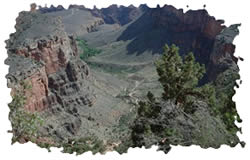
Dimdima
Online Children's Magazine from India

Dimdima
Online Children's Magazine from India

Last weekend, while wandering through the desert, I encountered a group of people who had just returned from an exhausting, but exhilarating hike across the Grand Canyon. This dangerous hike, dubbed by avid hikers as the 'rim-to-rim' hike is not a task for the faint of heart. In this two-part series, I will share some excerpts from a lengthy chat I had with one of the hikers, Priyo Sinha. To learn more about the complexities of the Grand Canyon, read on-
Rashmi: What does the term rim-to-rim hike mean?
Priyo: The term, -Rim to Rim - means traveling from one edge (known as 'rim') of the Grand Canyon to the other in a single trip. Some people like to refer to it simply as 'R2R'. There are only two ways of doing this: riding a hired mule all the way, or traversing the distance on foot, which is the more adventurous way.
Rim-to-rim hikers descend on foot from the top of the canyon at one end to the bottom, then ascend to the top of the canyon at the other end (again on foot!). Though the eastern and western boundaries of the Grand Canyon are called East Rim and West Rim, the two 'rims' in the term ''rim-to-rim' refer to the North Rim and the South Rim.
Of course, going from one end to the other by driving around the canyon is certainly not considered going rim-to-rim.' In fact, hiking from one rim to the bottom and back to the same rim is also generally not described as a rim-to-rim hike either (though it is challenging in its own right).
Rashmi: Why is the hike such a major challenge?
Priyo: There are several factors that make this hike so challenging:
(a) Sheer distance: The distance from the North Rim to the bottom of the canyon (through which the famous Colorado River flows) is 24 km (15 miles). Add to that the 16 km (10 miles) distance from the river to the South Rim, and it makes for a tough 40 km walk.
(b) ...and that is not even considering the change in elevation!! The North Rim is approximately at 8000 feet above sea level, which means by the time one has reached the river (at 2000 feet above sea level), one has lost 6000 feet of elevation. Although some people find the constant pressure on the knees and heels rather painful at times, this is the 'easy'' part of the hike. The difficult part is walking up to the other rim because climbing to the South Rim involves an elevation gain of 5000 feet.
(c) Climatic variations: Due to the substantial change in elevation between the rims and the bottom of the canyon, a hiker experiences drastic change in climate, especially temperature. For example, in summer the top of the rims are cool whereas the bottom of the canyon can be extremely hot and dry.
(d) Hiking in the Grand Canyon is unique because it is 'reverse mountaineering,' i.e. the hikers climb down first and then climb up. Thus, in this case, the difficult part of the hike has to be done when one is already tired after covering a lot of distance.
Rashmi: What are some of the interesting facts about the GC that you learned while researching the hiking experience?
Priyo: One fact that really surprised me was that out of the nearly 5 million tourists who visit Grand Canyon every year, only 1 percent hike below the rim. Needless to say, only a fraction of them actually hike from one rim to the other! There are several hiking trails that start from a rim and reach the river, but only three of them are maintained by the National Park personnel who manage the Grand Canyon. Two of these are the Bright Angel Trail and South Kaibab Trail.
The rest are all un-maintained trails, which means it can often be difficult to follow the trail because it may have got covered by sliding rocks or plants.
Another surprising fact is that some human civilizations, commonly known to modern-day archaeologists as the Desert Archaic people are believed to have lived in the Grand Canyon as early as the 3rd millennium (3000 years) ago. They were followed by the Anasazi and Pueblo civilizations, both of which occupy a prominent place in the ancient tribes of Arizona and New Mexico.
I was also fascinated by the tremendous variety of plant and animal life found in the canyon; there are 75 known species of mammals, 50 species of reptiles and amphibians, several fish and hundreds of species of birds. This is not surprising, considering the dramatic variations in vegetation in different parts of the canyon, from vast forests of pine trees in the North Rim to numerous cacti and other succulents (plants that store water in their stems and braches to survive in desert conditions) in the bottom.
Last but not the least, many cliffs and unique rock formations in the Grand Canyon are named after eastern spiritual or cultural icons. There is a Vishnu Temple, Shiva Temple, Zoroaster Temple and Ottoman Amphitheatre. Most of these were named by John Wesley Powell, who was an avid reader of Asian history and philosophy!!
To be continued...
Dimdima is the Sanskrit word for ‘drumbeat’. In olden days, victory in battle was heralded by the beat of drums or any important news to be conveyed to the people used to be accompanied with drumbeats.
Bharatiya Vidya Bhavan
K. M Munshi Marg,
Chowpatty, Mumbai - 400 007
email : editor@dimdima.com
Bharatiya Vidya Bhavan
505, Sane Guruji Marg,
Tardeo, Mumbai - 400 034
email : promo@dimdima.com
Dimdima.com, the Children's Website of Bharatiya Vidya Bhavan launched in 2000 and came out with a Printed version of Dimdima Magazine in 2004. At present the Printed Version have more than 35,000 subscribers from India and Abroad.